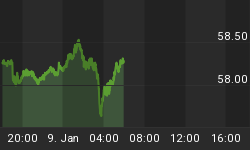Very little has changed from last week. There are still troubling signs with regards to this price advance -- volume is the most notable. The economy is clearly in stall speed as 4th Quarter GDP was under consensus, and the Fed had the notion to let investors know that rates will be low through 2015. But none of that seems to matter or to put it another way, it will matter when it does. The current market environment is looking more and more like quarter 4, 2010, which was heralded by QE2. This time the printing press is with the European Central Bank, but the Fed is doing a great job jawboning the market higher, and they are ready and willing to expand their balance sheet even more. Like quarter 4, 2010, both the Dollar and Treasury bonds have peaked out. (Editor's note: the Treasury bond data has not been published yet.) So what's left? It's equities and commodities. It is in these kinds of extremes of bullish sentiment that market melt ups happen. For now, we need to respect this dynamic. The bulls have the ball in their court and are on the cusp of turning this recent low volume price move into a multi-month barn burner.
The "Dumb Money" indicator (see figure 1) looks for extremes in the data from 4 different groups of investors who historically have been wrong on the market: 1) Investors Intelligence; 2) MarketVane; 3) American Association of Individual Investors; and 4) the put call ratio. This indicator shows extreme bullishness.
Figure 1. "Dumb Money"/ weekly
Figure 2 is a weekly chart of the SP500 with the InsiderScore "entire market" value in the lower panel. From the InsiderScore weekly report: "Insider trading volume remained seasonally light last week as the vast majority of U.S.-listed public companies prepared for their imminent Q4'11 (or comparable fiscal quarter) earnings announcements. As a reminder, most companies prohibit insiders from trading from approximately ten days before the end of a quarter until after the subsequent earnings announcement (anywhere from 1 day to until the 10-Q is filed, typically). With the first big tranche of earnings reports due this week, insider trading volume should begin to pick up and the transaction pipeline will begin to flow in earnest the second week of February."
Figure 2. InsiderScore "Entire Market" value/ weekly
Figure 3 is a weekly chart of the SP500. The indicator in the lower panel measures all the assets in the Rydex bullish oriented equity funds divided by the sum of assets in the bullish oriented equity funds plus the assets in the bearish oriented equity funds. When the indicator is green, the value is low and there is fear in the market; this is where market bottoms are forged. When the indicator is red, there is complacency in the market. There are too many bulls and this is when market advances stall. Currently, the value of the indicator is 66.66%. Values less than 50% are associated with market bottoms. Values greater than 58% are associated with market tops.
Figure 3. Rydex Total Bull v. Total Bear/ weekly
TheTechnicalTake offers a FREE e-newsletter: HERE
















